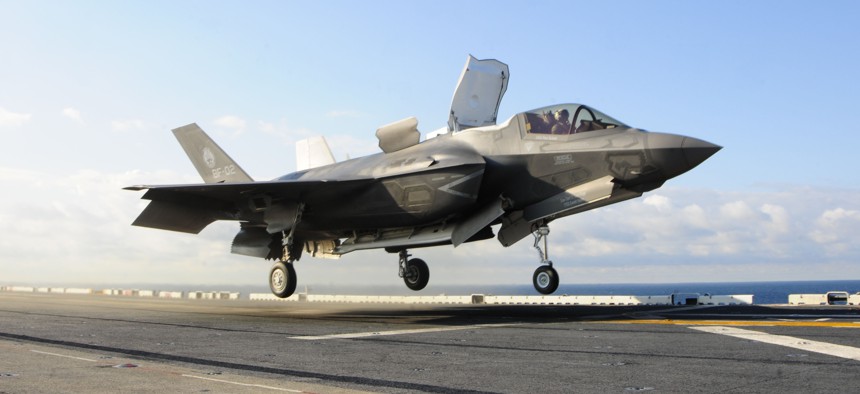
One of the Marine Corps' F-35Bs lifts off the flight deck of the USS Wasp during a test. Navy Media Content Services
The F-35 Won't Be Going To War Against ISIS Just Yet
The U.S. Marine Corps will declare its vertical-flight Joint Strike Fighter ready for war in July, but a top general says it’s unlikely the jets will head to Iraq any time soon.
When the V-22 Osprey was certified battle-ready in 2007, the U.S. Marine Corps sent the half-helicopter, half-plane straight to Iraq. That is unlikely to happen with the Marines’ latest aircraft, the F-35B Joint Strike Fighter, which is to be declared ready for war this summer.
“[I]f I had my druthers, I’d rather not deploy it right away, because I’d like to build some momentum in the program and build the instructor base,” Lt. Gen. Jon Davis, the Marine Corps deputy commandant for aviation, said Tuesday at a Defense Writers Group breakfast.
The Marines plan to declare 10 of their F-35B jets battle-ready in July. But the Corps is still racing to train instructor pilots on the short-takeoff-vertical-landing aircraft, and sending any of them off to war would disrupt the carefully planned training pipeline.
Davis didn’t completely rule out the possibility that the F-35s might be quickly deployed against the Islamic State in Iraq. “It could have a very great capability out there against the ISIS targets out there,” Davis said. “If they wanted to deploy it that way [and] we want to deploy it that way, we could.”
Meanwhile, there are a few hurdles left to clear before the F-35s can receive their certification. All 10 aircraft need to have the same mission software configuration. The planes’ maintenance computer system — dubbed ALIS, for Autonomic Logistics Information System — must be up and running; it has had its share of hiccups during F-35 development. Currently, the version of ALIS installed on ships does not work with the F-35’s Pratt & Whitney engine. Maintenance workers will have to use a special laptop as a workaround until a fix arrives by December, Davis said.
“Unless something really weird happens, I think we’ll be fine,” Davis said.
Over the next two weeks, six Marine F-35Bs will conduct operational testing from the USS Wasp amphibious assault ship.
Even after the F-35Bs are declared battle-ready, they will not immediately be able to conduct all of their planned mission types. Early on, the jets will only be able to fly escort, armed reconnaissance, close air support and interdiction missions, Davis said. The planes will also only be able to carry bombs internally in a weapons bay and not on wing pylons.
The aircraft will not have a gun pod and will not be able to use the full complement of air-launched weapons; among the initially missing armaments will be the Small Diameter Bomb II. Nor will they be able to stream video, Davis said.
The Marine Corps version of the F-35 is different from the versions flown by the Air Force and the Navy. That is because it can take off from very short runways and land vertically, allowing it to fly from Navy amphibious assault ships, which are much smaller than aircraft carriers.




